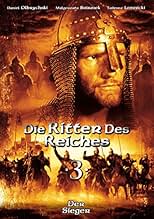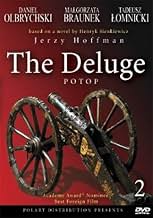NOTE IMDb
7,7/10
3,5 k
MA NOTE
Ajouter une intrigue dans votre langueDuring the 1655 war between Protestant Sweden and Catholic Polish-Lithuanian Commonwealth some Polish-Lithuanian nobles side with Swedish king Charles X Gustav while others side with the Pol... Tout lireDuring the 1655 war between Protestant Sweden and Catholic Polish-Lithuanian Commonwealth some Polish-Lithuanian nobles side with Swedish king Charles X Gustav while others side with the Polish king Jan Kazimierz.During the 1655 war between Protestant Sweden and Catholic Polish-Lithuanian Commonwealth some Polish-Lithuanian nobles side with Swedish king Charles X Gustav while others side with the Polish king Jan Kazimierz.
- Réalisation
- Scénario
- Casting principal
- Nommé pour 1 Oscar
- 4 victoires et 1 nomination au total
Avis à la une
10slug-5
This movie is an epic tale set in the 17th century Poland
were there is a war between the Swedish and the Polish armies. The turning point of this movie is when a Polish general betrays Poland and kills thousands of olish men. This movie had an academy award nomination but didn't win.
were there is a war between the Swedish and the Polish armies. The turning point of this movie is when a Polish general betrays Poland and kills thousands of olish men. This movie had an academy award nomination but didn't win.
10denis888
A highly recommended great patriotic film, 4 hours long but still a real feast for all lovers of novels by Sienkiewicz. This is truly a deep insight into the terrible beast that is war. Bravery, cowardice, romanticism, cruelty, friendship, blood - all is here, and all add to the masterpiece of Mr. Hoffman. Pay attention to the excellent play of the main hero, Adam Kmicic, mastered by the national Polish star Daniel Olbrychski. You feel both empathy and sympathy to him in all his heroic and tragic endeavors, yet he perseveres and wins in the end. This is a film not only for Poles or Russians (this movie was and is a great success in my homeland), but if you are interested in the 17th's century history and the events of the Swedish attack on Poland, this is the story for you.
What sets Potop ('The Deluge') apart from the majority of international films is that it manages to escape the art-house ghetto that so many are resigned to, and stand on its own as an engaging piece of storytelling with memorably-drawn characters.
Director Jerzy Hoffman had nearly all of this handed to him on a silver platter. Based on the massive second volume of Henryk Sienkiewicz's Polish Trilogy, Potop follows the crimes, tribulations, and redemption of the nobleman Andrei Kmicic, set against the backdrop of the Swedish Invasion of the Polish-Lithuanian Commonwealth. As a historical epic it is unparalleled, akin more to the works of Tolkien than Dumas, and this all comes down to the strength of the narrative, setting, events, and characterizations, all of which are suitably larger-than-life. Sienkiewicz himself would never really top his work here, and it's no surprise that Hoffman's adaption of the third book in the Trilogy (Pan Wolodyjowski, filmed first though it was the third book) did and does not register much. (It's the weakest book of the three by far).
Though its four-hour runtime will probably repel most American viewers, Potop does contain at least one showstopper sequence that earns its place in film history and cult-movie fandom: this is the sword-fight between the desperate Kmicic and the knight Pan Wolodyjowski. The scene only lasts around 5 minutes, but is such a carefully choreographed, Kurosawan wonder (the actors are visibly using real swords) that it is rightfully considered one of film's all-time greatest sword fights. Throughout the film Hoffman shows a keen aptitude for shooting carnage, but possibly at the expense of everything else; he seems to have little interest in cinematic blocking, and the most effective scene from the book (Radziwill's abrupt betrayal) is rendered strangely flat and unaffecting. With a production this massive, however, perhaps expectations should be a bit tempered.
Potop is a curious contrast to another immensely popular Polish blockbuster, 'Krzyzacy' (Knights of the Teutonic Order, also based on a book by Sienkiewicz), and filmed 14 years earlier in 1960. Krzyzacy was a gorgeously made film with cinematography about on par with Hollywood, but was populated by shallow stock characters and driven by (as per the depiction in a the film) a somewhat vapid youthful romance. The romantic angle in Potop is far superior, with the central relationship between Kmicic and Olenka far more developed and emotionally-wrought than that of Krzyzacy. That being said, the cinematography is uglier and the set-pieces simpler in Potop; maybe because of the extended runtime the budget seems somewhat reduced, the filmmaking less professional. The two films are an interesting microcosm of classic filmmaking versus 70s filmmaking; despite the latter's immovable grasp on the hearts of movie fans, it marked a decided decline in the technical professionalism seen during previous decades. Ultimately, however, Potop remains the better film due to its thematic breadth and narrative complexity.
Director Jerzy Hoffman had nearly all of this handed to him on a silver platter. Based on the massive second volume of Henryk Sienkiewicz's Polish Trilogy, Potop follows the crimes, tribulations, and redemption of the nobleman Andrei Kmicic, set against the backdrop of the Swedish Invasion of the Polish-Lithuanian Commonwealth. As a historical epic it is unparalleled, akin more to the works of Tolkien than Dumas, and this all comes down to the strength of the narrative, setting, events, and characterizations, all of which are suitably larger-than-life. Sienkiewicz himself would never really top his work here, and it's no surprise that Hoffman's adaption of the third book in the Trilogy (Pan Wolodyjowski, filmed first though it was the third book) did and does not register much. (It's the weakest book of the three by far).
Though its four-hour runtime will probably repel most American viewers, Potop does contain at least one showstopper sequence that earns its place in film history and cult-movie fandom: this is the sword-fight between the desperate Kmicic and the knight Pan Wolodyjowski. The scene only lasts around 5 minutes, but is such a carefully choreographed, Kurosawan wonder (the actors are visibly using real swords) that it is rightfully considered one of film's all-time greatest sword fights. Throughout the film Hoffman shows a keen aptitude for shooting carnage, but possibly at the expense of everything else; he seems to have little interest in cinematic blocking, and the most effective scene from the book (Radziwill's abrupt betrayal) is rendered strangely flat and unaffecting. With a production this massive, however, perhaps expectations should be a bit tempered.
Potop is a curious contrast to another immensely popular Polish blockbuster, 'Krzyzacy' (Knights of the Teutonic Order, also based on a book by Sienkiewicz), and filmed 14 years earlier in 1960. Krzyzacy was a gorgeously made film with cinematography about on par with Hollywood, but was populated by shallow stock characters and driven by (as per the depiction in a the film) a somewhat vapid youthful romance. The romantic angle in Potop is far superior, with the central relationship between Kmicic and Olenka far more developed and emotionally-wrought than that of Krzyzacy. That being said, the cinematography is uglier and the set-pieces simpler in Potop; maybe because of the extended runtime the budget seems somewhat reduced, the filmmaking less professional. The two films are an interesting microcosm of classic filmmaking versus 70s filmmaking; despite the latter's immovable grasp on the hearts of movie fans, it marked a decided decline in the technical professionalism seen during previous decades. Ultimately, however, Potop remains the better film due to its thematic breadth and narrative complexity.
10Enzyme7
A grand epic based on the writings of Henryk Sienkiewicz, The Deluge presents to its audience a gritty world saturated with betrayal and ruin, heroism and patriotism. Outstanding costume design paired with a brilliant cast led to a greatly rich depiction of Slavic aristocracy. Daniel Olbrychski's larger-than-life portrayal of Andrzej Kmicic aptly accomplishes the solemn bearing of a nobleman combined with hints of mania and barbarity.
The story engrosses with its beautiful cinematography, excellent character development, and cultural and historical insights into the Polish nation. The Deluge falls nothing short of monumental.
The story engrosses with its beautiful cinematography, excellent character development, and cultural and historical insights into the Polish nation. The Deluge falls nothing short of monumental.
I'd just like to add that "The Deluge" contained the best battle scenes made for the next 20 years till the movie "Barveheart", but even now they're still impressing. Hoffman managed to do that without any special effects and in the times when Poland was a communistic country and the budget was smaller than the amount of money middle class actors in Hollywood get now paid.
Except the battle scenes, it's impossible to not see the wonderful costumes and decorations. They're not only beautiful, but they create the climate of the 17th century better, than the often artificial decorations in Hollywood movies made for any century.
The film's time is about six hours. To tell the truth, I doubt that the Americans would have made this movie nowadays for less than a 100 mln $. Jerzy Hoffman could have dreamed at the best of that kind of money for his film and still, he made one of the best movies in history of cinema and the best in the history of Polish cinema.
Except the battle scenes, it's impossible to not see the wonderful costumes and decorations. They're not only beautiful, but they create the climate of the 17th century better, than the often artificial decorations in Hollywood movies made for any century.
The film's time is about six hours. To tell the truth, I doubt that the Americans would have made this movie nowadays for less than a 100 mln $. Jerzy Hoffman could have dreamed at the best of that kind of money for his film and still, he made one of the best movies in history of cinema and the best in the history of Polish cinema.
Le saviez-vous
- AnecdotesThe third most popular film in the history of Polish cinema, with more than 27.6 million tickets sold in its native country by 1987, and 30.5 million sold in the Soviet Union.
- ConnexionsFeatured in Sexify: Épisode #1.6 (2021)
Meilleurs choix
Connectez-vous pour évaluer et suivre la liste de favoris afin de recevoir des recommandations personnalisées
- How long is The Deluge?Alimenté par Alexa
Détails
- Date de sortie
- Pays d’origine
- Langue
- Aussi connu sous le nom de
- The Deluge
- Lieux de tournage
- Pidhirtsi, Lviv Oblast, Ukraine(battle scenes)
- Sociétés de production
- Voir plus de crédits d'entreprise sur IMDbPro
Box-office
- Budget
- 100 000 000 PLN (estimé)
Contribuer à cette page
Suggérer une modification ou ajouter du contenu manquant



































